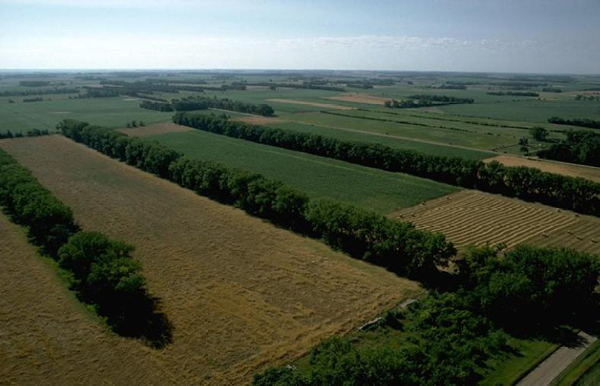
Tree shelterbelts are commonly grown throughout the world for windbreaks, privacy, livestock protection, soil management, wildlife conservation, etc. What is not so common is growing food producing shelterbelts for investment purposes.
Why do this to make money? It seems to me that most people will not tackle a substantial project like this unless there’s a way to make money at it. Of course, it’s good to plant trees for environmental reasons. But when you look around you don’t see large numbers of people planting lots of trees just to help the environment unless they’re forced to by severe dust storms like in China or Africa. Hopefully people won’t wait until things get that bad. Showing them how to make money at it should help win over more people.
One basic premise of real estate development is buy low and sell high. Right now it’s very easy to find degraded land. Search our blog for previous stories on ‘restoring degraded land’ that profile many different projects worldwide and some of the different techniques that are being used to turn wasteland or very low quality land into highly productive land. A big added bonus is you can use these ideas to create an affordable homestead. That’s what we’ve been doing for the last four years. See our Sustainable Homesteading YouTube channel for details.
Summary of basic concepts:
– Buy low cost marginal land where you want to live and where water is available.
– Plant a shelterbelt of food producing trees and shrubs around the perimeter of the land. Choose hearty species that are easy to grow in your area. You can always add fancier varieties later on. Also note, you don’t have to plant a complete forest garden shelterbelt the first year. You could plant the main trees and possibly some shrubs, and add other plants later.
– Plan carefully to minimize costs and labor. For example, consider hiring a mini excavator for digging tree holes. From experience, I’ve learned that digging dozens of tree holes in hard soil is back breaking work that takes weeks. This is a great fitness plan if you have loads of time, but here we’re looking at how to do things efficiently. A mini excavator can dig dozens of tree holes in one day. At the same time the excavator could dig swales, etc. as the budget allows. If your focus is on turning a profit then you might want to hold off on additional earthwork and just get the main trees started. Sometimes earthwork is required. Plan carefully.
– Learn how to plant trees for a high survival rate. Key points include using mycorrhizal rich compost in tree holes, mulch on top and reliable irrigation. Fence the property if at all possible to help keep livestock out. And make sure the fence is high enough. I didn’t realize how agile some cows can be until I caught one in our garden yesterday. After being shooed away it jumped right back over a low area in the fence almost like a deer.
Image: Oklahoma Forestry Services

We had some surprise visitors in the forest garden this morning. There were at least two new morning doves. One hopped up on a low branch to check me out before flying off to join their friend. This is great news because modern agriculture has killed off almost all birds here. Any birds in the area will obviously enjoy the trees, cooler temperature, insects and lily pool. Hope they stick around.
Another key benefit of course is food self sufficiency. You’ll always have food even if the stores are closed someday. Plus, fresh homegrown produce is far tastier and healthier than eating out of cans, boxes and plastic bags. Right now I’m making dozens of small veggie beds in between trees in our forest garden. Details will be in an upcoming blog post.